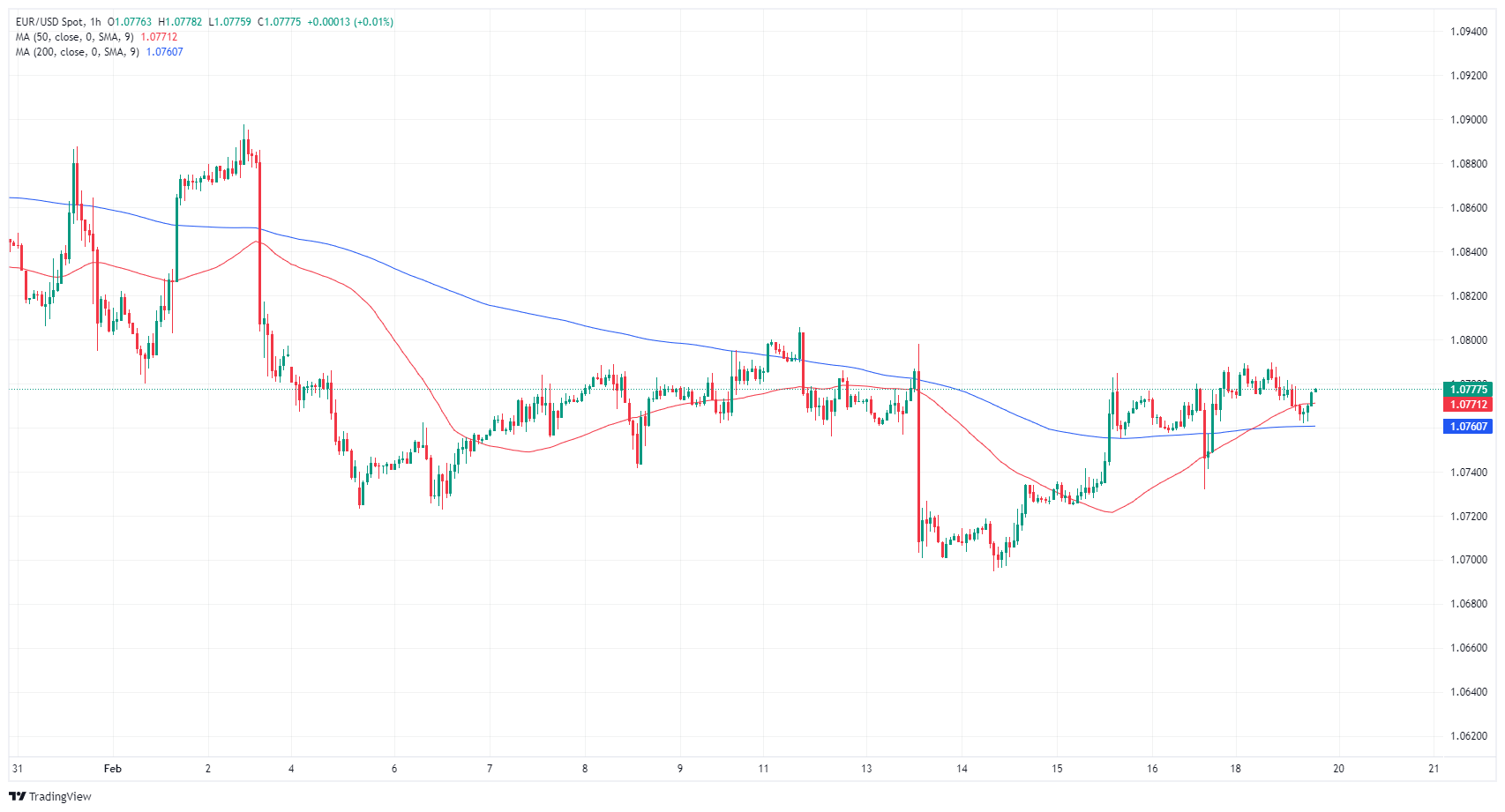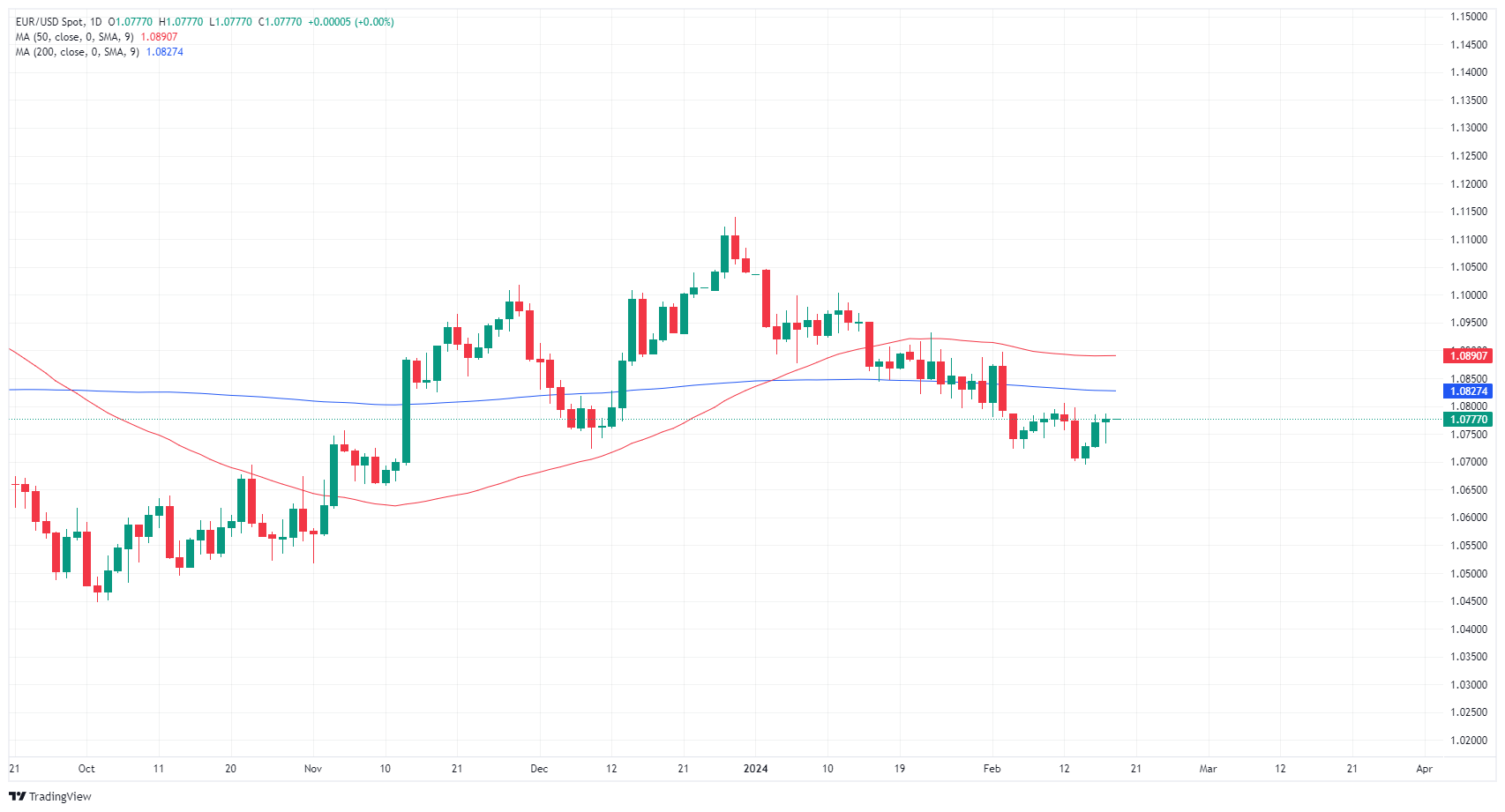EUR/USD churns on quiet Monday as investors look ahead to late-week European PMIs

- EUR/USD pared back into technical congestion on Monday.
- European economic calendar looks thin until Thursday’s PMI prints.
- Fed FOMC Meeting Minutes due Wednesday ahead of European and US PMIs.
EUR/USD drifted back into median prices in thin Monday trading as the pair remains hampered below 1.0800. Markets opened on a quiet note with US markets dark for the US federal holiday. US liquidity will return to the fold beginning on Tuesday.
European and US Purchasing Managers Index (PMI) figures are due in the latter half of the trading week, and investors will be looking forward to the latest Meeting Minutes from the US Federal Reserve’s (Fed) Federal Open Market Committee (FOMC). According to the CME’s FedWatch Tool, markets see a 75% chance of a rate cut from the Fed in June as higher-than-expected US inflation figures continue to push money markets further down the calendar after the early year’s sky-high bets of a March rate cut evaporating.
Daily digest market movers: EUR/USD cycles in familiar territory as markets wait for data
- US Presidents’ Day market holiday sees a quiet Monday with low volumes.
- Fed watchers are forced to wait until Wednesday for the FOMC’s latest Meeting Minutes.
- Investors will be looking for clues to determine how near (or far) the Fed is to delivering the first rate cut.
- European Consumer Confidence for February, slated to print on Wednesday, is expected to recover to -15.6 from -16.1.
- FOMC Meeting Minutes will draw investor curiosity as traders look for signs the Fed is getting closer to delivering a rate trim.
- Thursday’s economic calendar is densely-packed with pan-European and US PMIs slated to print throughout the day.
- The Euro area Composite PMI for February is expected to print higher at 48.5 than the previous 47.0, but still in contraction territory below 50.0 for a ninth consecutive month.
- The US S&P PMIs are expected to soften slightly, with February’s Manufacturing PMI forecast to decrease to 50.5 from 50.7.
Euro price today
The table below shows the percentage change of Euro (EUR) against listed major currencies today. Euro was the weakest against the New Zealand Dollar.
| USD | EUR | GBP | CAD | AUD | JPY | NZD | CHF | |
| USD | 0.06% | 0.14% | 0.10% | 0.00% | 0.06% | -0.15% | 0.22% | |
| EUR | -0.06% | 0.09% | 0.03% | -0.06% | 0.00% | -0.21% | 0.16% | |
| GBP | -0.14% | -0.09% | -0.05% | -0.14% | -0.09% | -0.29% | 0.08% | |
| CAD | -0.09% | -0.03% | 0.05% | -0.09% | -0.03% | -0.25% | 0.12% | |
| AUD | 0.00% | 0.06% | 0.15% | 0.09% | 0.05% | -0.15% | 0.22% | |
| JPY | -0.05% | 0.00% | 0.11% | 0.04% | -0.06% | -0.22% | 0.15% | |
| NZD | 0.16% | 0.21% | 0.29% | 0.25% | 0.15% | 0.21% | 0.38% | |
| CHF | -0.23% | -0.16% | -0.08% | -0.13% | -0.22% | -0.19% | -0.37% |
The heat map shows percentage changes of major currencies against each other. The base currency is picked from the left column, while the quote currency is picked from the top row. For example, if you pick the Euro from the left column and move along the horizontal line to the Japanese Yen, the percentage change displayed in the box will represent EUR (base)/JPY (quote).
Technical analysis: EUR/USD mixes on quiet Monday, churns familiar territory below 1.0800
EUR/USD remains pinned below the 1.0800 handle as the pair struggles to develop momentum after finding a fresh low last week near 1.0700. Intraday technical action is getting hampered by the 200-hour Simple Moving Average (SMA) near 1.0760, and a near-term technical ceiling is priced in near 1.0790.
EUR/USD closed in the green for seven of the last ten consecutive trading days, but harsh downside pullbacks leave the pair adrift on the low side of the 200-day SMA near 1.0830, and the pair found a fresh 13-week low last week near 1.0700.
EUR/USD hourly chart
EUR/USD daily chart
Euro FAQs
The Euro is the currency for the 20 European Union countries that belong to the Eurozone. It is the second most heavily traded currency in the world behind the US Dollar. In 2022, it accounted for 31% of all foreign exchange transactions, with an average daily turnover of over $2.2 trillion a day.
EUR/USD is the most heavily traded currency pair in the world, accounting for an estimated 30% off all transactions, followed by EUR/JPY (4%), EUR/GBP (3%) and EUR/AUD (2%).
The European Central Bank (ECB) in Frankfurt, Germany, is the reserve bank for the Eurozone. The ECB sets interest rates and manages monetary policy.
The ECB’s primary mandate is to maintain price stability, which means either controlling inflation or stimulating growth. Its primary tool is the raising or lowering of interest rates. Relatively high interest rates – or the expectation of higher rates – will usually benefit the Euro and vice versa.
The ECB Governing Council makes monetary policy decisions at meetings held eight times a year. Decisions are made by heads of the Eurozone national banks and six permanent members, including the President of the ECB, Christine Lagarde.
Eurozone inflation data, measured by the Harmonized Index of Consumer Prices (HICP), is an important econometric for the Euro. If inflation rises more than expected, especially if above the ECB’s 2% target, it obliges the ECB to raise interest rates to bring it back under control.
Relatively high interest rates compared to its counterparts will usually benefit the Euro, as it makes the region more attractive as a place for global investors to park their money.
Data releases gauge the health of the economy and can impact on the Euro. Indicators such as GDP, Manufacturing and Services PMIs, employment, and consumer sentiment surveys can all influence the direction of the single currency.
A strong economy is good for the Euro. Not only does it attract more foreign investment but it may encourage the ECB to put up interest rates, which will directly strengthen the Euro. Otherwise, if economic data is weak, the Euro is likely to fall.
Economic data for the four largest economies in the euro area (Germany, France, Italy and Spain) are especially significant, as they account for 75% of the Eurozone’s economy.
Another significant data release for the Euro is the Trade Balance. This indicator measures the difference between what a country earns from its exports and what it spends on imports over a given period.
If a country produces highly sought after exports then its currency will gain in value purely from the extra demand created from foreign buyers seeking to purchase these goods. Therefore, a positive net Trade Balance strengthens a currency and vice versa for a negative balance.
